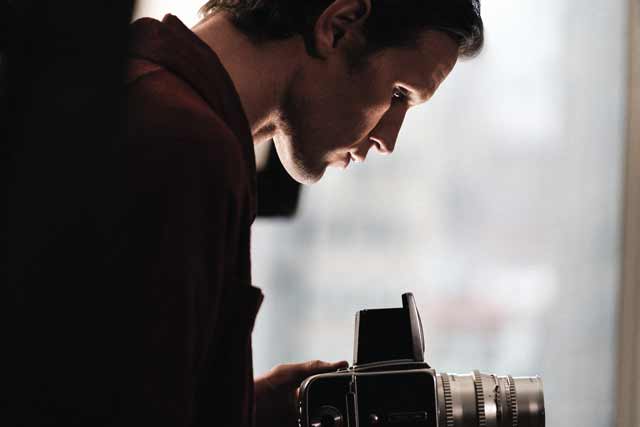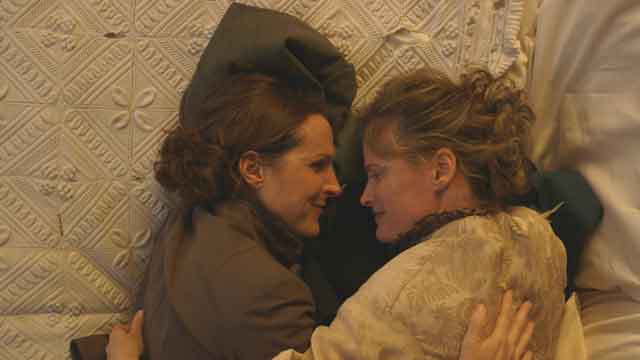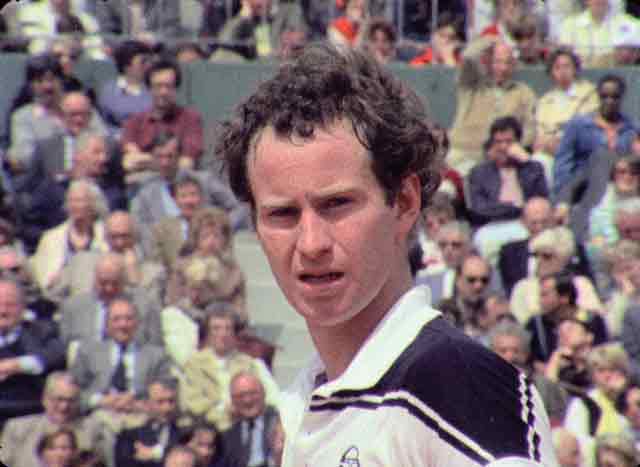Robin Williams in 1988 from Come Inside My Mind directed by Marina Zenovich
Navigating the Truth in High-Profile Biographies
by Rebecca M. Alvin
Every year when the Film Festival comes around, there is a selection of films that run the gamut in terms of form, content, and point of view. But sometimes there is a serendipitous connection that can be seen in looking through the program. This year, for whatever reason, there are a striking number of biographical films on offer that feature well known subjects and thematic connections of fame, creativity, and genius. As a sub genre of documentary and a distinct genre in fiction filmmaking known as the biopic, these films traverse lines between our expectations as an audience and the essential truths about their subjects’ lives. No one lives a life according to three-act Hollywood script structure. No person is just one way all the time. No life is simple enough to completely reveal in a film. And yet, the expectations for telling the “real story” are hard to reign in.
Marina Zenovich’s documentary Robin Williams: Come Inside My Mind has the difficult task of taking a larger-than-life character who’s been in the public eye for several decades and giving us something new.

“It’s kind of like a combination between being a private investigator and like a wannabe psychologist trying to figure all of this stuff out,” Zenovich says of the documentarian’s job. “Everyone thinks they know everything, but when you end up specializing on a specific topic, my goal is always to find footage people haven’t seen, to look in the nooks and crannies that people don’t know about,” she adds.
The title for the film comes from one of Williams’ comedy riffs from the 1970s, and the film succeeds in bringing new dimensions to what we thought we knew about Williams, using rarely seen interviews, stripping the audio from the original video and layering it over entirely different imagery. Williams discusses his life and work in a documentary made about Juilliard, the prestigious performing arts school he attended, on old TV talk shows, and even in an audiotape a journalist kept from when he interviewed him for Playboy magazine many years ago. It is the arrangement of these archival gems, intercut with interviews with his family, friends, and colleagues that brings out the film’s central message about Williams: he made people laugh because he had to.
“It is really about Robin and his genius, for lack of a better word. Kind of his spirit and soul, and it was all tied to his finding himself, his work ethic, his need to perform,” Zenovich explains.

starring Molly Shannon and Susan Ziegler.
What the film spends less time on is the elephant in the room, Williams’ suicide in 2014. So often when people die by suicide, the questions feel so urgent it is hard to get past them, and certainly Williams’ first wife Valerie Velardi, comedian Billy Crystal, and family members do address his death, but it is not overdone or morbid.
“I did not have to bring it up, people brought it up,” Zenovich recalls. “It was trying to be more of a celebration, and even though that sounds kind of horrible, he lived so fully and he touched so many people, and he lived such a full life. It is sad. It’s heartbreaking. But it’s also that he was so invigorating with his endless, boundless energy.”
If the challenge of making biographical documentaries is in finding existing footage and people who can and will talk about the subject in a revealing way, filmmakers who choose to make the biopic, that is the scripted biographical film, are charged with recreating someone with actors, dialogue, and created sets that are elements of fiction, but at the same time must tell a true story. For Ondi Timoner, working with truth in cinema has been a lifelong pursuit. Timoner has made numerous documentaries over the past 20 years, but when it came to the subject of controversial artist Robert Mapplethorpe, Timoner made the move to scripted filmmaking. The resulting biopic, Mapplethorpe premiered earlier this year at the Tribeca Film Festival, and makes its way to Provincetown this week.
“I don’t actually do retrospectives. Typically, I don’t do historical docs,” Timoner says of her motivation. “My theory when I got involved in making docs was just that I was interested in taking people on a ride. And that included bringing everything alive. So, I was never interested in using photos and found footage and trying to piece together Robert Mapplethorpe. I was always interested in seeing him alive on screen.”
The film stars Matt Smith (Dr. Who, 2009-2013) as the brilliant photographer whose work later became the center of the NEA funding controversy in the late 1980s, and it takes us from his youth as Patti Smith’s best friend, lover, and soul mate through his eventual coming out as a gay man and explosive career in the art world. It also focuses a significant amount of time on Mapplethorpe’s family and the connections and disconnections there, ultimately leaving us with a portrait that balances his fragility as a person with his many deep flaws.
“I know people cry at the end of the movie, and I know some people are angry with him and don’t get over it. But what I hope happens is that everyone leans into it and grapples with judgment, and then, hopefully, realizes that judgment is futile,” Timoner explains. “I think Hollywood in a way has done a disservice with making everything white hats and black hats, and that’s not how people are. I think it’s important that people growing up get some characters that they don’t really know what to do with. They’re great and at the same time they’re assholes… We all know people like that, so I didn’t want to turn Robert Mapplethorpe into a caricature.”
While creating a film about someone like Mapplethorpe, who lived not that long ago, requires careful research, and in this case, came with the support of the Robert Mapplethorpe Foundation, another film in the festival this year takes the long deceased Emily Dickinson as its subject in a scripted film starring comedian Molly Shannon in the title role. Wild Nights with Emily puts forth a vision of the brilliant poet that does not conform to our conventional impression of her as a reclusive, moody spinster. Writer/director Madeleine Olnek presents Dickinson as a very intentional “spinster” who lived next door to her brother, whose wife was her lover. The fantasy of Emily Dickinson as a lesbian is not particularly audacious, but rather it is Shannon’s portrayal that, no pun intended, extends poetic license in this film. Who ever thought of Emily Dickinson as a lovable goofball? The pairing of that with the real poetry she wrote, which is of course stunningly beautiful, makes the film a unique blend of fact and fiction that could only be made about someone we think we know everything about and who has been sort of relegated to the history books at this point. Certainly the film brings her off the dusty bookshelves and gives new life to her, which is one of the great things about biographical films: the way they reignite our interest in people.
This is true of all the films mentioned. Mapplethorpe brings you back to when you first saw his work with its stunning contrast between blacks and whites, a theme that is explored fully both in the script and in the visual strategy of the film. Come Inside My Mind reminds you how quick and frenetic Williams’ comedy was while also offering new footage that makes his unique mind a little more accessible. And Wild Nights with Emily lets us reimagine the poet and look at her work with fresh eyes. In every case, the film itself does not introduce us to these people, but it does re-acquaint us with them and reveal dimensions to their personalities and their work that enrich our understanding of their lives.
Conceptual Biography

If Mapplethorpe and Come Inside My Mind offer us carefully researched, nuanced portraits of their respective subjects and Wild Nights with Emily allows for an alternative vision of a venerable poet, John McEnroe: In the Realm of Perfection takes the expectations of biographical documentary and turns them on their head. You might think you are about to see a film about the great tennis player, and in essence you are, but it will have few biographical details, no interviews, and the focus will be on impressions gleaned from films by a McEnroe enthusiast who made instructional tennis films in the McEnroe era.
Centered on the 1984 Roland-Garros French Open, French director Julie Faraut uses the character of McEnroe in this crucial moment in his career as a way to explore notions of time, motion, expectations, celebrity, and competition. The narration, written by Faraut and delivered by Mathieu Amalric, asks us to look at tennis in a conceptual manner, comparing it to cinema, even. McEnroe’s caustic personality, the tension in his body, and the beauty of his skill are magnified by this close reading of his performance—both as a tennis player and as a human being. We start to see the vulnerabilities come through the cracks, but only because the method of documentation here is so relentlessly obsessive. You will learn nothing and everything about McEnroe in looking at this very unique take on biographical cinema.
The Provincetown International Film Festival is June 13 – 18 at various venues in Provincetown and Wellfleet. To find out when the films in this story are being shown visit the Festival box office on the first floor of Whalers Wharf mall , 237 Commercial St., Provincetown, call 508.246.9171, or visit provincetownfilm.org.











